International Toy Fair Nuremberg 2010
Internationale Spielwarenmesse Nürnberg 2010
| x |
|
|
|
|
|
|
|
|
|
|
|
|
|
|
|
|
|
|
|
|
|
|
|
|
|
|
|
|
|
|
|
|
|
|
| Kosmos |
|
|
| x |
|
|
|
|
|
|
|
|
|
|
|
|
|
|
|
|
|
|
|
|
|
|
|
|
|
|
|
|
|
|
|
|
|
|
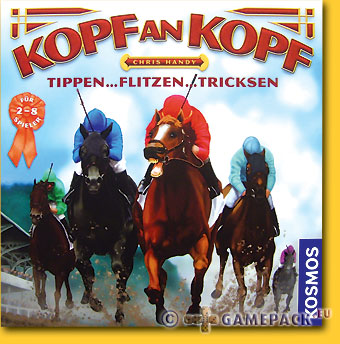 |
Yet another racing game; the genre never dies. Here players not only bet on horses, they also can buy them. Played action cards influence the race, hopefully in the players favor. The player with the most money... |
|
| There are ten horses in the race and as many horse cards; bet chips as many per colour as there are players. The players are dealt three action cards from a deck of 104. |
|
| x |
|
|
|
|
|
|
|
|
|
|
|
|
|
|
|
|
|
|
|
|
|
|
|
|
|
|
|
|
|
|
|
|
|
|
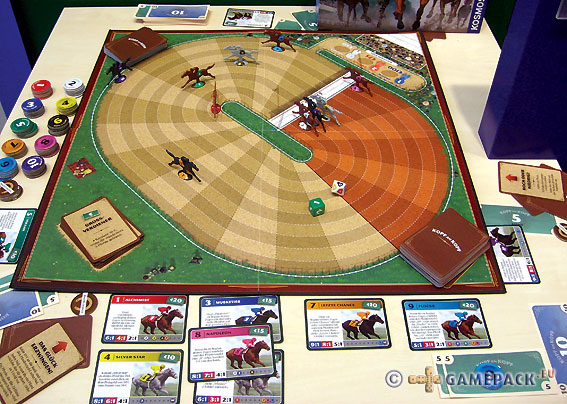 |
|
| x |
|
|
|
|
|
|
|
|
|
|
|
|
|
|
|
|
|
|
|
|
|
|
|
|
|
|
|
|
|
|
|
|
|
|
| In a turn, a player may buy a horse. If he already has one, he executes all the special abilities that are depicted on the horse card. After this, he throws two dice, a horse die and a movement die. This shows which horse may move how many spaces. |
|
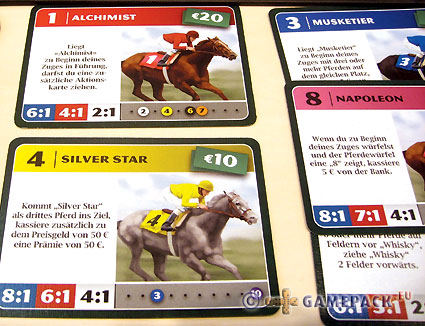 |
|
| x |
|
|
|
|
|
|
|
|
|
|
|
|
|
|
|
|
|
|
|
|
|
|
|
|
|
|
|
|
|
|
|
|
|
|
A player now may move his own horse(s) for a sprint if the result of the die is on the horse card as a socalled sprint number. The number is the amount of spaces that may be moved.
He then may play an action card and follow the instructions on the card. Gray cards may be played when it is another player's turn.
A horse may be bought from the bank and the amount on the card must be paid. The price of the horse gets higher when there are more sprint numbers on the card. |
|
| x |
|
|
|
|
|
|
|
|
|
|
|
|
|
|
|
|
|
|
|
|
|
|
|
|
|
|
|
|
|
|
|
|
|
|
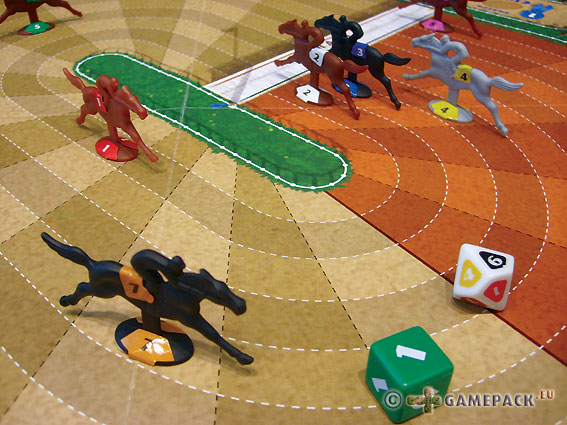 |
|
| x |
|
|
|
|
|
|
|
|
|
|
|
|
|
|
|
|
|
|
|
|
|
|
|
|
|
|
|
|
|
|
|
|
|
|
A player could also opt to bet on a horse. He pays 5 money and takes a bet chip with the number of the horse from the general supply. in furture rounds, he may place another or the same bet, filing the money under the bet chip of the appropriate horse. When a horse is in the brown area of the track no bets may be made for that horse.
The game ends immediately after the third horse has crossed the finish line. Revenues are paid and the winner takes it all... |
|
| x |
|
|
|
|
|
|
|
|
|
|
|
|
|
|
|
|
|
|
|
|
|
|
|
|
|
|
|
|
|
|
|
|
|
|
| Kopf an Kopf, Chris Handy, Kosmos, 2010 - 2 to 8 players, 10 years and up, 60 minutes |
|
| x |
|
|
|
|
|
|
|
|
|
|
|
|
|
|
|
|
|
|
|
|
|
|
|
|
|
|
|
|
|
|
|
|
|
|
| x |
|
|
|
|
|
|
|
|
|
|
|
|
|
|
|
|
|
|
|
|
|
|
|
|
|
|
|
|
|
|
|
|
|
|
| x |
|
|
|
|
|
|
|
|
|
|
|
|
|
|
|
|
|
|
|
|
|
|
|
|
|
|
|
|
|
|
|
|
|
|
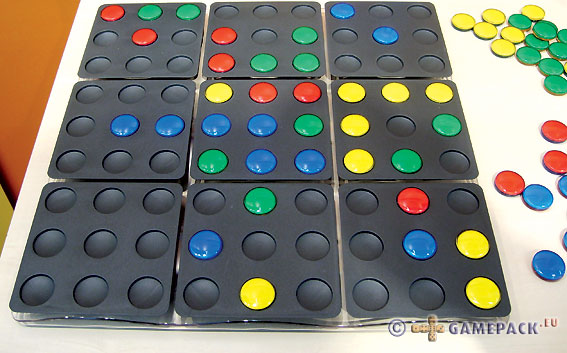 |
|
| x |
|
|
|
|
|
|
|
|
|
|
|
|
|
|
|
|
|
|
|
|
|
|
|
|
|
|
|
|
|
|
|
|
|
|
| In 'Pentago' players alternatively place a stone in their colour. The player who manages to complete a series of five has won. Trick is that the board consists of nine squares that can be turned. After a player has placed a stone he may choose any one square to turn it 90 degrees, either way. This requires some 'projection' thinking in this four in a row variant. |
|
| x |
|
|
|
|
|
|
|
|
|
|
|
|
|
|
|
|
|
|
|
|
|
|
|
|
|
|
|
|
|
|
|
|
|
|
| Pentago, Thomas Flodén & Pål Keller Cariquist, Kosmos, 2010 - 2 to 4 players, 8 years and up, 15 minutes |
|
| x |
|
|
|
|
|
|
|
|
|
|
|
|
|
|
|
|
|
|
|
|
|
|
|
|
|
|
|
|
|
|
|
|
|
|
| x |
|
|
|
|
|
|
|
|
|
|
|
|
|
|
|
|
|
|
|
|
|
|
|
|
|
|
|
|
|
|
|
|
|
|
| x |
|
|
|
|
|
|
|
|
|
|
|
|
|
|
|
|
|
|
|
|
|
|
|
|
|
|
|
|
|
|
|
|
|
|
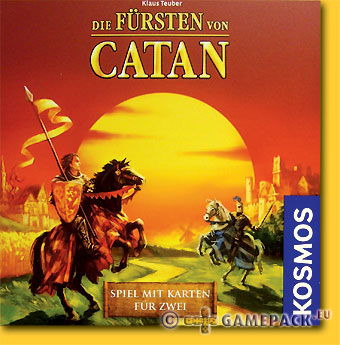 |
Siedler - The Card Game got refurnished and turned into a game with... knights! We love knights, we think knights all day, we eat them for supper, dinner, we dream about knights, we even dress like them - according to the game industry; otherwise it cannot be explained why most game themes handle about knights and never about a witful tailer with tight pink pants, oh well...
The game has new attractive artwork, and comes already with two modules that formerly were sold seperately. Nice. |
|
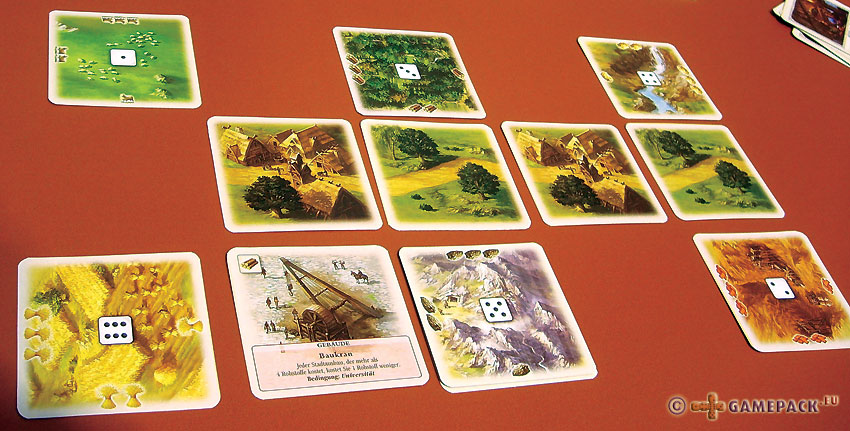 |
| x |
|
|
|
|
|
|
|
|
|
|
|
|
|
|
|
|
|
|
|
|
|
|
|
|
|
|
|
|
|
|
|
|
|
|
| Die Fürsten von Catan, Klaus Teuber, Kosmos, 2010 - 2 players, 10 years and up, 60-90 minutes |
|
| x |
|
|
|
|
|
|
|
|
|
|
|
|
|
|
|
|
|
|
|
|
|
|
|
|
|
|
|
|
|
|
|
|
|
|
| x |
|
|
|
|
|
|
|
|
|
|
|
|
|
|
|
|
|
|
|
|
|
|
|
|
|
|
|
|
|
|
|
|
|
|
| x |
|
|
|
|
|
|
|
|
|
|
|
|
|
|
|
|
|
|
|
|
|
|
|
|
|
|
|
|
|
|
|
|
|
|
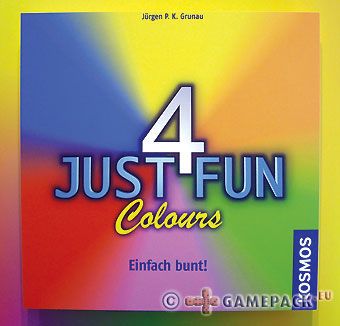 |
|
Don't change anything on this release! Well, maybe just the colours?
You can't count? Then you're stupid! But Kosmos loves you, and has released this version for you. But at least you'll have to recognise colours! Don't start me on that!
Players play colour cards instead of numbers to occupy a coloured space. If the space is already occupied with a stone of another player, he must play two colour cards, and more if there are more stones on the space. There is no more blocking; a player always is able to place his stone on a space - if he is able to play that many coloured cards. Just4Fun is a nice game - it really is. 'Colours' will be a nice game too. |
|
| x |
|
|
|
|
|
|
|
|
|
|
|
|
|
|
|
|
|
|
|
|
|
|
|
|
|
|
|
|
|
|
|
|
|
|
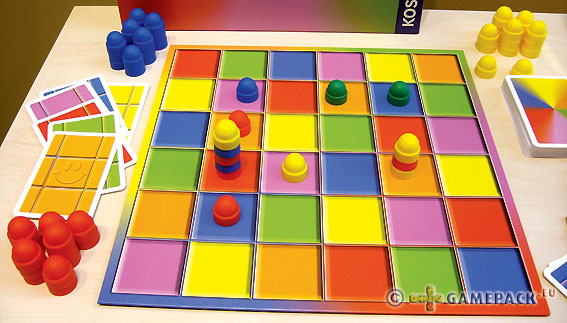 |
|
| x |
|
|
|
|
|
|
|
|
|
|
|
|
|
|
|
|
|
|
|
|
|
|
|
|
|
|
|
|
|
|
|
|
|
|
| Just4Fun Colours, Jürgen P. Grunau, Kosmos, 2010 - 2 to 4 players, 8 years and up, 15 minutes |
| x |
|
|
|
|
|
|
|
|
|
|
|
|
|
|
|
|
|
|
|
|
|
|
|
|
|
|
|
|
|
|
|
|
|
|
| x |
|
|
|
|
|
|
|
|
|
|
|
|
|
|
|
|
|
|
|
|
|
|
|
|
|
|
|
|
|
|
|
|
|
|
| x |
|
|
|
|
|
|
|
|
|
|
|
|
|
|
|
|
|
|
|
|
|
|
|
|
|
|
|
|
|
|
|
|
|
|
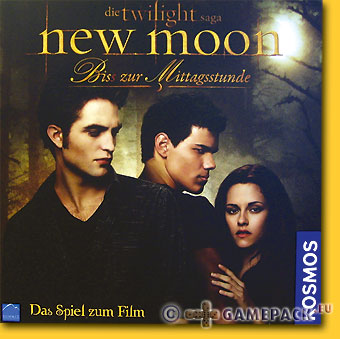 |
Players take on the roles of the characters in the movie of the same name, thereby enduring exciting challenges and answering questions about the movie. The more a player knows about the books or the movies, the more chance he has to win. But some luck is inevitable.
This reminds me of the rather obscure game 'Metromania' from 1985, a Trivial Pursuit clone, that handles about all sorts of facts about New York. I mean: little facts. Small. Tiny. Detailed. Microscopic. I had to answer questions I did not know there were sentences made for that. I never left the start line. My companion by accident, luck or otherwise was two spaces in front of me. We aborted the game. It's somewhere on a shelf. Large box. Huge. I believe it has 3000 unanswered questions. Why do I keep it anyway? Because it's so weird! |
|
| x |
|
|
|
|
|
|
|
|
|
|
|
|
|
|
|
|
|
|
|
|
|
|
|
|
|
|
|
|
|
|
|
|
|
|
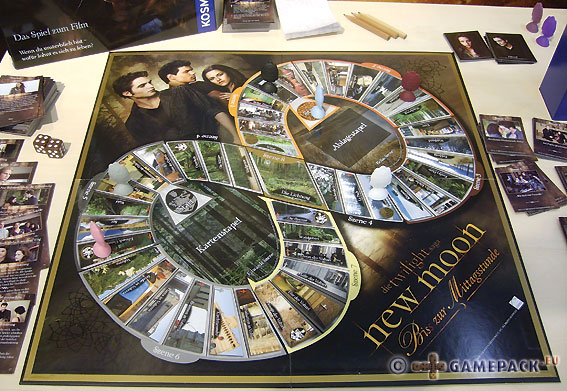 |
|
| x |
|
|
|
|
|
|
|
|
|
|
|
|
|
|
|
|
|
|
|
|
|
|
|
|
|
|
|
|
|
|
|
|
|
|
| New Moon, no author mentioned, Kosmos, 2010 - 2 to 8 players, 13 years and up, 60 minutes |
|
| x |
|
|
|
|
|
|
|
|
|
|
|
|
|
|
|
|
|
|
|
|
|
|
|
|
|
|
|
|
|
|
|
|
|
|
| x |
|
|
|
|
|
|
|
|
|
|
|
|
|
|
|
|
|
|
|
|
|
|
|
|
|
|
|
|
|
|
|
|
|
|
| x |
|
|
|
|
|
|
|
|
|
|
|
|
|
|
|
|
|
|
|
|
|
|
|
|
|
|
|
|
|
|
|
|
|
|
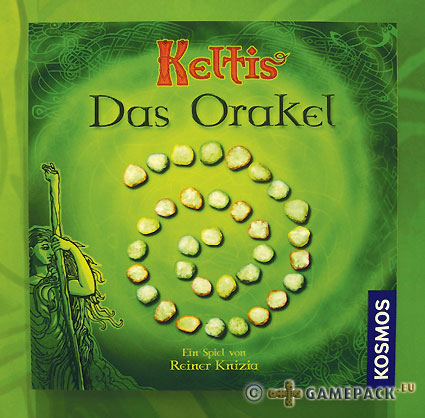 |
|
May I say it? May I? You won't blame me for it?
The author is Dr. Reiner Knizia, the Man with the Title and magician with a thousand tricks upon his sleeve. You briefly looked to the side? He has a new game for you! You had to powder your nose? Here's a stack of four! And they're all green!
His favourite colour nowadays is green (yes I know, it's hard to be green...) |
|
| x |
|
|
|
|
|
|
|
|
|
|
|
|
|
|
|
|
|
|
|
|
|
|
|
|
|
|
|
|
|
|
|
|
|
|
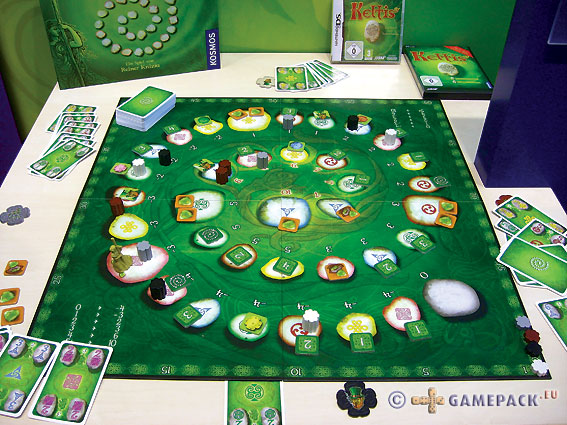 |
|
| x |
|
|
|
|
|
|
|
|
|
|
|
|
|
|
|
|
|
|
|
|
|
|
|
|
|
|
|
|
|
|
|
|
|
|
| 'Keltis - das Orakel' mainly follows the same rules as the basic game, with a few exceptions. There is only one spiral path. A player now has the ability to move back and forth, when on specific fields. There are new bonuses, for instance when the three stones of a player form a specific formation, or when a new figurine, the oracle lady, is moved. Because a player can choose to move any of his three stones in a turn, the game offers more flexibility - but this also requires more planning. |
|
| x |
|
|
|
|
|
|
|
|
|
|
|
|
|
|
|
|
|
|
|
|
|
|
|
|
|
|
|
|
|
|
|
|
|
|
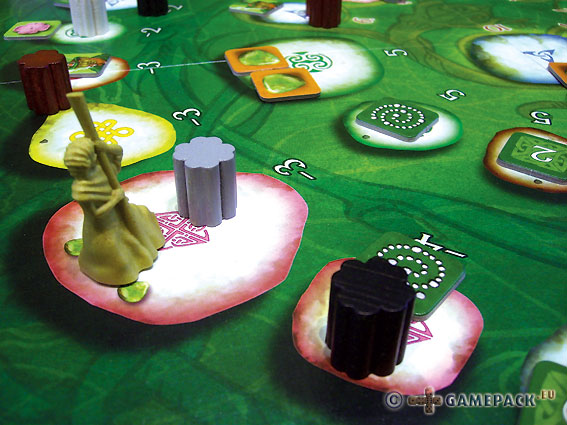 |
|
| x |
|
|
|
|
|
|
|
|
|
|
|
|
|
|
|
|
|
|
|
|
|
|
|
|
|
|
|
|
|
|
|
|
|
|
| Keltis - das Orakel, Reiner Knizia, Kosmos, 2010 - 2 to 4 players, 10 years and up, 45 minutes |
|
| x |
|
|
|
|
|
|
|
|
|
|
|
|
|
|
|
|
|
|
|
|
|
|
|
|
|
|
|
|
|
|
|
|
|
|
| x |
|
|
|
|
|
|
|
|
|
|
|
|
|
|
|
|
|
|
|
|
|
|
|
|
|
|
|
|
|
|
|
|
|
|
| c |
|
|
|
|
|
|
|
|
|
|
|
|
|
|
|
|
|
|
|
|
|
|
|
|
|
|
|
|
|
|
|
|
|
|
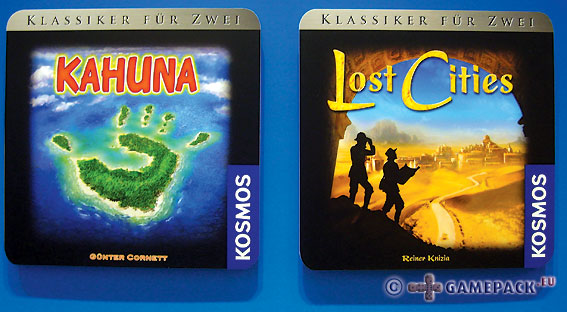 |
|
| x |
|
|
|
|
|
|
|
|
|
|
|
|
|
|
|
|
|
|
|
|
|
|
|
|
|
|
|
|
|
|
|
|
|
|
| Both games not new, but polished and put in a tin box. The cards of Kahuna seem to be somewhat thicker - and that is always a good thing. The oversized cards for Lost Cities stayed - and that's good also. |
|
| x |
|
|
|
|
|
|
|
|
|
|
|
|
|
|
|
|
|
|
|
|
|
|
|
|
|
|
|
|
|
|
|
|
|
|
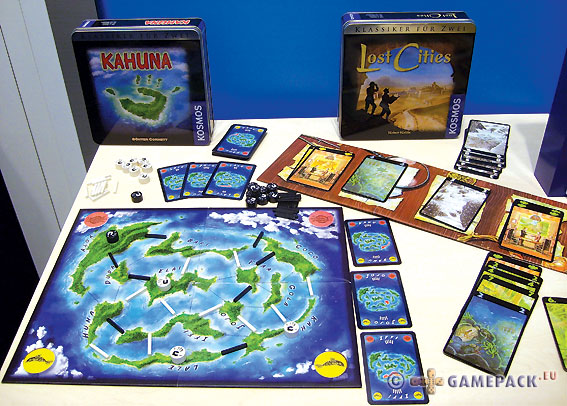 |
|
| x |
|
|
|
|
|
|
|
|
|
|
|
|
|
|
|
|
|
|
|
|
|
|
|
|
|
|
|
|
|
|
|
|
|
|
| Lost Cities, Reiner Knizia - Kahuna, Günther Cornett, Kosmos, 2010 - 2 players, 10 years and up, 30 minutes |
|
| x |
|
|
|
|
|
|
|
|
|
|
|
|
|
|
|
|
|
|
|
|
|
|
|
|
|
|
|
|
|
|
|
|
|
|
| x |
|
|
|
|
|
|
|
|
|
|
|
|
|
|
|
|
|
|
|
|
|
|
|
|
|
|
|
|
|
|
|
|
|
|
| x |
|
|
|
|
|
|
|
|
|
|
|
|
|
|
|
|
|
|
|
|
|
|
|
|
|
|
|
|
|
|
|
|
|
|
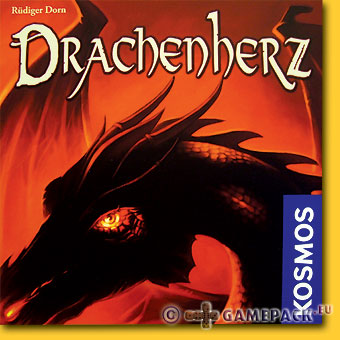 |
Each of the two players has his own but identical deck of fifty cards that he shuffles, after which he takes five of them in his hand.
One player starts and plays one or more cards of the same drawing, after which he refills his hand to five cards. The cards are placed on the corresponding drawing. At some places, the cards are merely collected, at others the cards are placed a bit off line so it is clear how many cards are already placed there. |
|
| x |
|
|
|
|
|
|
|
|
|
|
|
|
|
|
|
|
|
|
|
|
|
|
|
|
|
|
|
|
|
|
|
|
|
|
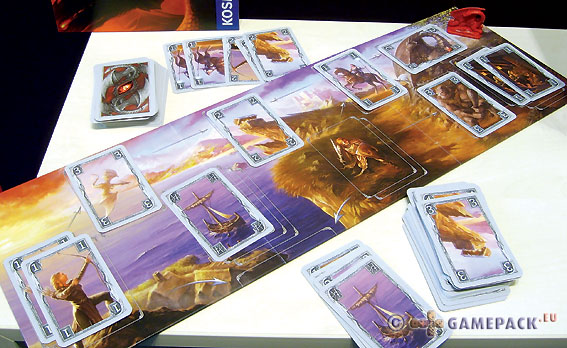 |
|
| x |
|
|
|
|
|
|
|
|
|
|
|
|
|
|
|
|
|
|
|
|
|
|
|
|
|
|
|
|
|
|
|
|
|
|
| By placing cards, actions can be triggered; on fields where cards are collected this occurs immediately, otherwise only when a certain amount of cards has been played at that field. If an arrow points from that field to another field, the cards on the latter may be taken; the cards show varying values in points. |
|
| x |
|
|
|
|
|
|
|
|
|
|
|
|
|
|
|
|
|
|
|
|
|
|
|
|
|
|
|
|
|
|
|
|
|
|
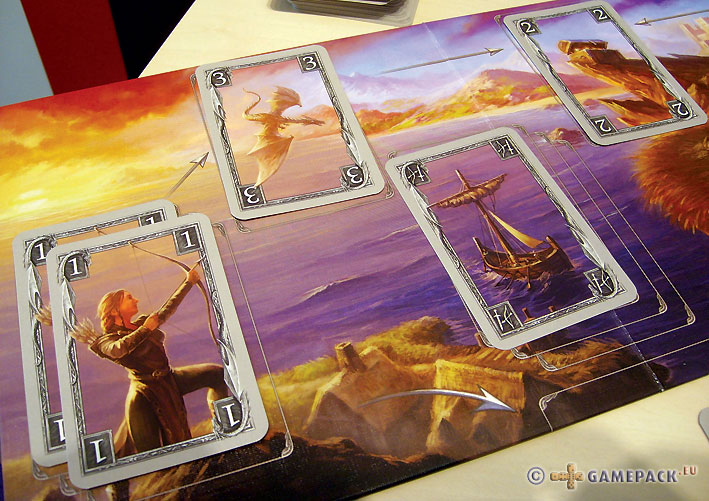 |
| x |
|
|
|
|
|
|
|
|
|
|
|
|
|
|
|
|
|
|
|
|
|
|
|
|
|
|
|
|
|
|
|
|
|
|
| The chest field merely assembles cards; no action is triggered when playing a card on this field; the fire dragon takes all chest cards. The fossilized dragon also triggers no action. |
|
| x |
|
|
|
|
|
|
|
|
|
|
|
|
|
|
|
|
|
|
|
|
|
|
|
|
|
|
|
|
|
|
|
|
|
|
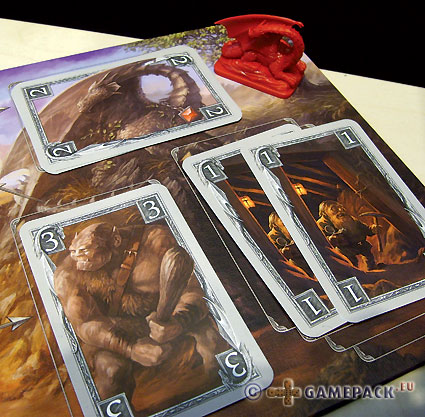 |
|
The princess either takes all the chests or all fossilized dragons. If a player decides for the latter, he takes the dragon figure. A player who owns the dragon may refill his hand at the end of his turn to six cards instead of five.
When playing the troll, a player may take all collected princess cards; with the fourth midget card a player may take all four midget cards.
Heroes and dragon hunters have similar abilities. The third ship on a field takes all underlying hero and dragon hunter cards. When for the third time a third ship card is played, the game ends and players count the value of their collected cards.
|
|
| x |
|
|
|
|
|
|
|
|
|
|
|
|
|
|
|
|
|
|
|
|
|
|
|
|
|
|
|
|
|
|
|
|
|
|
| Drachenherz, Rüdiger Dorn, Kosmos, 2010 - 2 players, 10 years and up, 30 minutes |
|
| x |
|
|
|
|
|
|
|
|
|
|
|
|
|
|
|
|
|
|
|
|
|
|
|
|
|
|
|
|
|
|
|
|
|
|
| x |
|
|
|
|
|
|
|
|
|
|
|
|
|
|
|
|
|
|
|
|
|
|
|
|
|
|
|
|
|
|
|
|
|
|
| x |
|
|
|
|
|
|
|
|
|
|
|
|
|
|
|
|
|
|
|
|
|
|
|
|
|
|
|
|
|
|
|
|
|
|
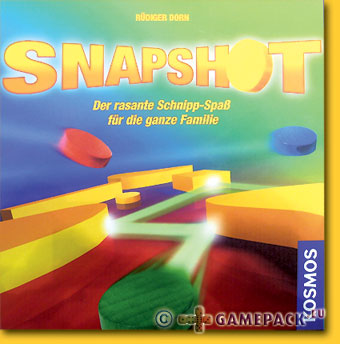 |
Snap your fingers, and score! A card states the goal you must hit. Objects are in the way or may be put aside if certain positions are taken. Resnap or snap again, whatever, if only you fulfil the order and collect gems along the way. Take another order, and go! The game ends when a player has fulfilled all his orders and has collected two gems of each kind. |
|
| x |
|
|
|
|
|
|
|
|
|
|
|
|
|
|
|
|
|
|
|
|
|
|
|
|
|
|
|
|
|
|
|
|
|
|
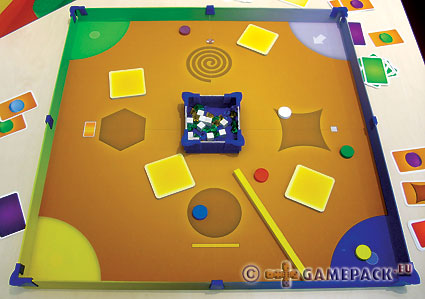 |
|
| x |
|
|
|
|
|
|
|
|
|
|
|
|
|
|
|
|
|
|
|
|
|
|
|
|
|
|
|
|
|
|
|
|
|
|
| Snapshot, Rüdiger Dorn, Kosmos, 2010 - 2 to 6 players, 8 years and up, 30 minutes |
|
| x |
|
|
|
|
|
|
|
|
|
|
|
|
|
|
|
|
|
|
|
|
|
|
|
|
|
|
|
|
|
|
|
|
|
|
| x |
|
|
|
|
|
|
|
|
|
|
|
|
|
|
|
|
|
|
|
|
|
|
|
|
|
|
|
|
|
|
|
 |
|
|
|
|
|
|
|
|
|
|
|
|
|
|
|
|
|
|
|
|
|
|
|
|
|
|
|
|
|
|
|
|
|
 |
|
|
|
|
|
|
|
|
|
|
|
|
|
|
|
|
|
|
|
|
|
|
|
|
|
|
|
|
|
|
|
|
|
 |
|
|
|
|
|
|
|
|
|
|
|
|
|
|
|
|
|
|
|
|
|
|
|
|
|
|
|
|
|
|
|
|
|
 |
|
|
|
|
|
|
|
|
|
|
|
|
|
|
|
|
|
|
|
|
|
|
|
|
|
|
|
|
|
|
|
|
|
 |
|
|
|
|
|
|
|
|
|
|
|
|
|
|
|
|
|
|
|
|
|
|
|
|
|
|
|
|
|
|
|
| x |
|
|
|
|
|
|
|
|
|
|
|
|
|
|
|
|
|
|
|
|
|
|
|
|
|
|
|
|
|
|
|
|
|
|
 |
|
|
|
|
|
|
|
|
|
|
|
|
|
|
|
|
|
|
|
|
|
|
|
|
|
|
|
|
|
|
|
|
|
|
|
|
|
|
|
|
|
|
|
|
|
|
|
|
|
|
|